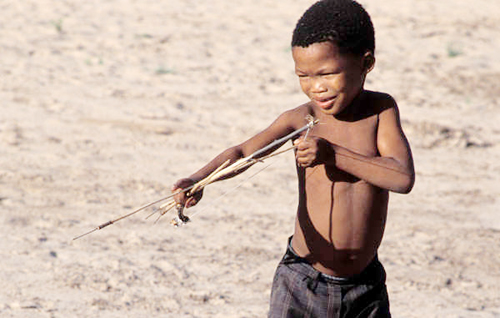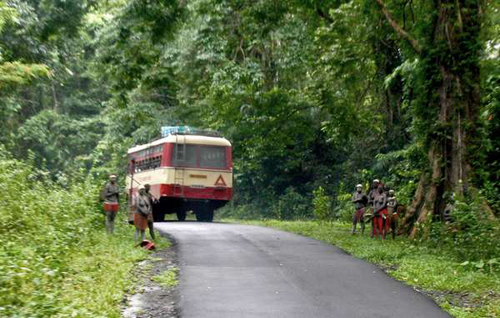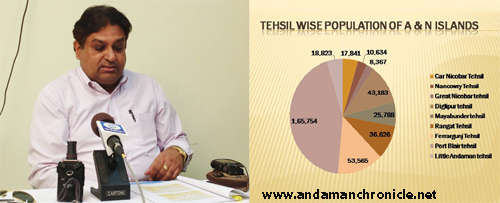- Details
- Denis Giles
- Hits: 1660

Survival International has received disturbing reports about an imminent eviction of several hundred Bushmen in southern Botswana to make way for a ‘wildlife corridor’.
The Bushman community at Ranyane has allegedly been told by the local government that trucks will arrive on Monday to remove them from land they have inhabited for generations. Their houses will be destroyed.
The Bushmen’s land is in a proposed ‘wildlife corridor’ which American organization Conservation International, whose Board members include Botswana’s President Khama, has pushed for over a period of many years. The land lies between the Central Kalahari Game Reserve (CKGR) and the Kgalagadi Transfrontier Park and is also occupied by some settlers and farms.
Survival International has contacted President Khama and Conservation International, voicing its opposition to the planned eviction of the Bushman community.
A Bushman told Survival, ‘We appeal to anyone who can, to help give their support to the Bushmen at Ranyane to fight for their right to stay on their land. The international community needs to know that what the government is doing is wrong.’
It is not the first time Botswana’s Bushmen have been targeted by the government in the name of conservation. In three brutal evictions between 1997 and 2005, thousands of Bushmen were removed from the Central Kalahari Game Reserve, supposedly for wildlife conservation. Bushmen forced off their land in 2002 went to court and in a landmark judgement Botswana’s High Court ruled in 2006 that the evictions were ‘unlawful and unconstitutional’.
Forcibly evicting tribal peoples from their ancestral lands has devastating impacts on their health and destroys their livelihoods and self sufficiency. In Botswana’s so-called ‘resettlement’ camps, Bushmen who have been removed from their land depend entirely on government handouts and frequently suffer from alcoholism, depression and many other illnesses.
- Details
- Denis Giles
- Hits: 2323

Just weeks after Survival International launched a tourism boycott of India’s Andaman Islands to stop the degrading ‘human safaris’ to the Jarawa tribe, the campaign has been gaining traction as travel companies join the boycott and thousands of people pledge not to visit the islands.
Following worldwide media coverage, with articles appearing in The Hindu in India, The Telegraph in the UK, International Business Times and the activism site Take Part in America, amongst many others, over two thousand people have pledged not to visit the islands until the tours are stopped.
Travelpickr, a global company based in Canada and India, and Spanish company Orixà Viatges are the first operators to withdraw from offering tours to the Andamans, and Survival is lobbying many more to join the boycott.
René Trescases, the head of Travelpickr, told Survival, ‘At Travelpickr we were appalled to learn about the ’human safaris’ to the Jarawa and have now withdrawn over forty tours to the Andaman Islands. We hope that the local administration will act quickly to stop this disgraceful practice, or it risks damaging the islands’ reputation as a popular travel destination.’
Spanish travel agency Orixà Viatges said, ‘We have removed the Andaman Islands from our list of tourist destinations. At Orixà Viatges we don’t understand this kind of tourism – we believe that people and cultures should be treated with respect, rather than used by unscrupulous people making a profit out of ‘human safaris’.’
Hundreds of tourists, the majority from India, Israel, America and Britain, travel along a road which runs through the Jarawa reserve on a daily basis. Many hope to spot a member of the 400-strong Jarawa tribe, whose ancestors are thought to have been part of the first human migration out of Africa, treating them like animals in a zoo.
The ‘human safaris’ have been condemned by the United Nations and India’s Minister for Tribal Affairs, who called them ‘disgraceful’ and ‘an embarrassment’, and thousands of letters have been sent to the Indian government asking for the tours to be stopped.
But despite an Indian Supreme Court ruling in January 2013 which temporarily stopped tourists from travelling along the road, the Andaman administration has done everything in its means to keep the road open to tourists – even changing its own rules on a buffer zone to enable the ‘human safaris’ to continue.
Survival’s Director Stephen Corry said today, ‘In travelers’ eyes, the Andamans are increasingly becoming synonymous with ‘human safaris’. The islands’ reputation has undoubtedly been severely damaged by the scandal. It’s surprising that the local government is so reluctant to provide tourists and locals with an alternative sea route, given that it’s far quicker and cheaper to travel by boat.’
Survival will continue to call for a full boycott of tourism to the Andaman Islands until its demands of removing tourists from the road through the Jarawa reserve are met, said a release from Survival International.
- Details
- Denis Giles
- Hits: 2350

Port Blair, May 22: The Census 2011 final population data of Andaman and Nicobar islands has been released today by the Director of Census Operations, N K Sharma at the Directorate of Census Operations at Port Blair among media persons and others.
Releasing the data, he announced the total population of the islands as 3,80,581 comprising 2,02,871 males and 1,77,710 females with the growth rate of 6.86 per cent. Despite the increase in the general population, the population of tribal people was decreased from 29,469 to 28,530 as compared to 2001 Census, registering a decrease of 3.19%.
On being asked the reason for decline in tribal population, Shri Yesodharan, Dy. Director, Census Operations revealed that the main reason is the Tsunami of 2004 wherein a lot of tribals in the Nicobar District had died. Another reason he said that there are a section of Nicobaris who donot want to be identified as Scheduled Tribes. They just want them to be registered as per their religion, he said and we cannot object.
The Dy. Director further revealed that there was good cooperation from other tribal group like the Jarawa and Shompens during the enumeration process. It was done with the help of the Tribal Welfare Department, said the Dy. Director. He also revealed that their department had also counted the Sentinelese by making two boat trips near the island, yet the exact population of the tribe is not clear due to the hostile behaviour of the tribe.
Meanwhile expressing happiness over the impressive growth of literacy rate in the islands, Shri NK Sharma said the final results showed a very good sign of progress in the literacy rate due to increased educational facilities extended under Sarva Shiksha Abhiyan and the land mark Right to Education programmes. He revealed that the literacy rate has been recorded as 86.6% with the growth rate of 5.3 per cent. The latest census also shows the remarkable literacy rate of 82.4 per cent among the females, as compared to 75.2 per cent in the 2001 census, where as the literacy rate among the males crossed 90 per cent in the current census.
The Director Census Operations also informed that the child sex ratio has been improved to 968, where as the adult sex ratio stood at 876 as against 846 in 2001 Census in the islands.
According to Census 2011, the working population of the Islands has been recorded as 1,52,535 workers comprising 1,20,889 males and 31,646 females, marking an increase from 38.26% to 40.08% in a decade. The rest of the population of 2,28,046 persons comprising 81,982 males and 1,46,064 females are non workers.
The population enumeration of these Islands was conducted from 9th to 28th February, 2011 with a revisional round from 1st to 5th March, 2011. The provisional population totals received from the Census Charge Officers had been compiled released on 28th March, 2011 along with other states and UTs of the country.
Among the others who briefed the media was Shri Amitabh Mitra, Assistant Director, Census Operations.